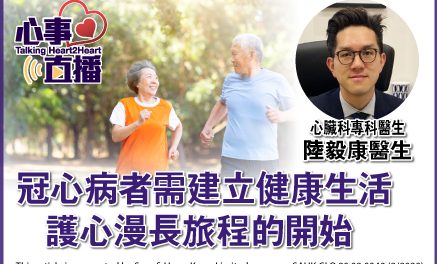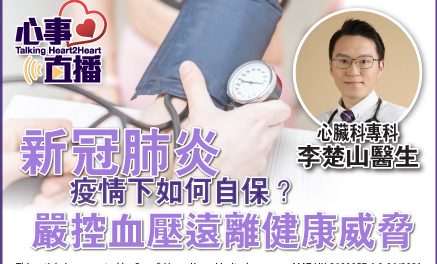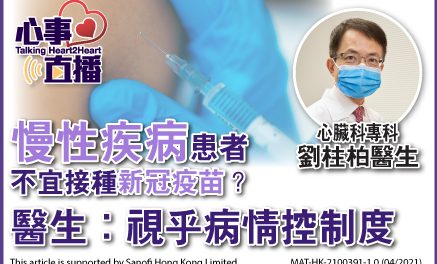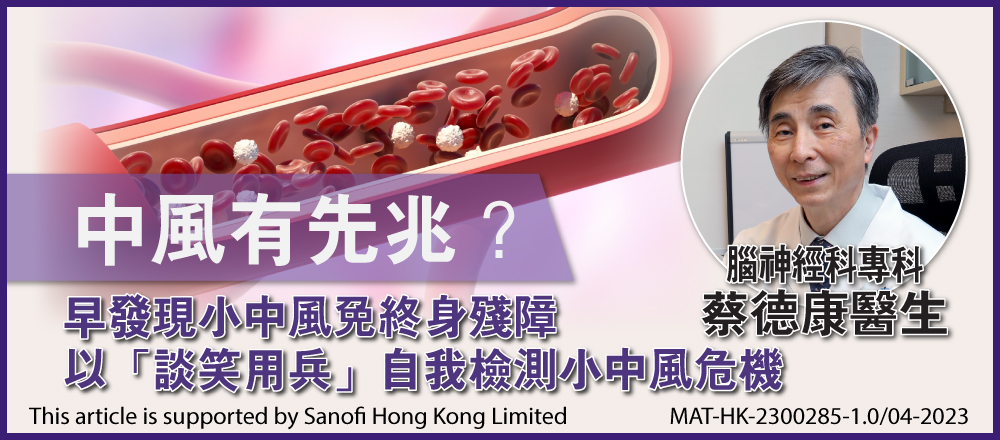
你知道什麼是小中風?小中風症狀有甚麼?相信大家都知一旦中風,得把握「黃金三小時」搶救。實在,人人都有機會中風,不然怎會每年10月29日定為世界中風日,提醒我們要注意健康。腦神經科專科醫生蔡德康以多年臨床經驗表示,中風個案不少,每次案例則要視乎腦部受影響的位置及有多嚴重,所導致的問題亦有不同。「腦缺血便是中風,約有八成是因腦血管阻塞,兩成為血管破裂¹,小中風即短暫缺血性中風²。為了預防中風發生,平日該注意自己的身體狀況,或可使用『談、笑、用、兵』四字口訣判斷是否屬小中風症狀,以便自我檢測小中風的危機。」
了解小中風症狀 及時就醫降低真正中風機率
蔡德康醫生稱中風乃急性腦血管疾病,當腦血管阻塞或血管破裂令血液無法供應給腦部,短時間內就會令腦細胞缺氧而使腦組織壞死 1。「有高血壓、高血糖、高血脂三高問題,或肥胖、食煙、飲酒等因素影響下,容易令血管阻塞或收窄,便有機會中風²,³。在醫學上,小中風是腦組織只有短暫缺血,好好彩堵塞的血管自行打通,腦組織沒有壞死,中風症狀亦在短時間內消失²。」
「小中風症狀跟中風症狀相同,腦功能突然出現障礙。小中風症狀通常發生在幾分鐘內至一小時,不會超過24小時。²」
中風多為突發性,蔡德康醫生認為可憑着「談笑用兵」四字口訣來判斷症狀⁴。「『談』,是指口齒不清或表達困難;『笑』即面部表情不對稱,或嘴歪眼斜;『用』,一邊手腳無力或麻痺;『兵』,當有以上三種症狀,立即求醫找救兵。¹,²」
蔡德康醫生警告:「雖說小中風症狀會在一小時內消失,但也別掉以輕心,是顯示血管收窄巳到嚴重程度,隨時會再堵塞而造成終身殘障的『大中風』²。有報告指出幾乎兩成小中風患者會在三個月內出視大中風,一半是在頭數天內發上⁵,⁶,⁷。」
由於港人食得好,或因生活習慣不良,容易導致血管病變,年紀愈大的,愈易患上中風⁸。但蔡德康醫生稱香港大學最新的研究顯示中風有年輕化跡象,18 – 55歲人士中風個案在近20年高出三成⁹。「當發生小中風症狀時,也許是防止永久殘障出現的最後通諜。建議大家留意身體狀況,認識小中風症狀。如果能夠發現症狀後及早求醫,可減少中風風險高達一半以上¹⁰。」

腦神經科專科醫生蔡德康建議,保特心腦血管健康,謹慎控制三高,均衡飲食,聽從醫生指示適當服用藥物,預防「中風」。
避免中風致終身癱瘓 控制三高預防中風
九十年代流行未患病先食通血管藥的想法,蔡德康醫生指出「打底」做法未必有得益,反而有機會產生副作用;但改善生活及飲食習慣,戒煙,少吃紅肉、多選擇低脂低糖低鹽的食物,定時做運動,每周做三次每次三十分鐘中等強度的帶氧運動,令身體微微出汗;更要控制體重,檢查會否心律不正等可以有效預防中風²,¹¹ ,亦不會有藥物副作用,所有人都適合,愈早開始對血管健康愈有幫助。一旦出現小中風或中風,除了要嚴格控制血管病高危因素,還須服用兩種抗血小板藥物,(Dual Antiplatelet Therapy, DAPT)去減少中風風險,療程為三周至三個月,之後要長期服用一種抗血小板藥物¹²。如發現是心源性中風,則要服用抗凝血藥(anticoagulant)¹³。
預防中風,可避免終身殘障,改善生活習慣愈早開始愈好。一旦出現出現小中風症狀,就要立刻求醫。找到問題隨即治療,把握最後機會避過厄運。
This article is supported by Sanofi Hong Kong Limited
MAT-HK-2300285-1.0/04-2023
參考資料:
- National Health Service.Stroke. 2022; published online Sept 13. https://www.nhs.uk/conditions/stroke/ (accessed April25, 2023).
- National Heakth Service.Transient ischaemic attack (TIA). 2020; published online Jan 21. https://www.nhs.uk/conditions/transient-ischaemic-attack-tia/ (accessed April25, 2023).
- ZhangZ, YanJ, ShiH.Hyperglycemia as a Risk Factor of Ischemic Stroke. J Drug Metab Toxicol 2013; 4. DOI:10.4172/2157-7609.1000153.
- LeungWC, TeoKC, KwokW, et al.Pre-hospital stroke screening and notification of patients with reperfusion-eligible acute ischaemic stroke using modified Face Arm Speech Time test. Hong Kong Med J 2020; 26: 479–85.
- EastonJD, SaverJL, AlbersGW, et al.Definition and Evaluation of Transient Ischemic Attack. Stroke 2009; 40: 2276–93.
- AmortM, FluriF, SchäferJ, et al.Transient ischemic attack versus transient ischemic attack mimics: frequency, clinical characteristics and outcome. Cerebrovasc Dis 2011; 32: 57–64.
- SadighiA, AbediV, StanciuA, et al.Six-Month Outcome of Transient Ischemic Attack and Its Mimics. Front Neurol 2019; 10. DOI:10.3389/FNEUR.2019.00294.
- Centers for Disease Control and Prevention.Know Your Risk for Stroke. 2023; published online March 23. https://www.cdc.gov/stroke/risk_factors.htm (accessed April25, 2023).
- HKUMed.HKUMed research shows 30% increase in ‘young stroke’ incidence in Hong Kong and calls for better control of vascular risk factors such as hypertension . 2022; published online Oct 27. https://www.med.hku.hk/en/news/press/20221027-increase-in-young-stroke (accessed April25, 2023).
- Centers for Disease Control and Prevention.Preventing Stroke Deaths. 2017; published online Sept 6. https://www.cdc.gov/vitalsigns/stroke/index.html (accessed April26, 2023).
- KleindorferDO, TowfighiA, ChaturvediS, et al.2021 Guideline for the Prevention of Stroke in Patients With Stroke and Transient Ischemic Attack: A Guideline From the American Heart Association/American Stroke Association. Stroke 2021; 52: E364–467.
- LeeK-Y.Antiplatelet Therapy for Secondary Stroke Prevention in Patients with Ischemic Stroke or Transient Ischemic Attack. Cardiovasc Prev Pharmacother 2021; 3: 86–94.
- TinoneG, HoshinoM, LucatoL, ComerlattiLR.Anticoagulation and Stroke. Arq Neuropsiquiatr 2022; 80: 72–9.
